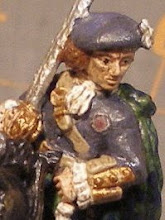As I stated in my previous post, "Bayou Wars- Battle at Plancenoit," the theme for our regional convention was "Epic Battles - 1215, 1415, 1615, and 1815." My second game of the convention was based around events in the 1415 Agincourt campaign. As you will recall the English army was short of supplies so I developed a game based on the "Convoy" scenario from the
Lion Rampant rules where an English force is attempting to get some supplies to the main army and the French are trying to stop them.
Each side had three 12-point balanced retinues, plus the English had one additional unit whose sole task was to escort the six laden pack animals. Each retinue had a mounted sergeants unit (6 figures), a foot sergeants unit (12 figures), and a foot missile unit (12 figures). The entire English command entered from one corner of the battlefield and had to make it diagonally across the battlefield to the opposite corner. The three French retinues each entered at one of the other corners with the task of intercepting the English and capturing the pack animals.
I only took three photos since I was trying to keep the game going smoothly and quickly.
 |
| One of the English commanders tries to move his troops. The English initially had problems motivating their troops but eventually got out to engage the French. |
 |
| The hand of one of the French commanders is moving his foot sergeants forward. This French commander had the worst luck with the dice (as usual for him) and lost all three of his units. This allowed the English to start ganging up on the other two French commanders. |
 |
| As their archers trail behind, another French retinue moves quickly past an unusual visitor. |
The English were finally able to destroy almost all of the French units and kill two of the three French commanders with the third falling back since he couldn't rally himself. So Henry got some supplies, fed his troops, and went on to glory at a place called Agincourt.
All of the troops are vintage medieval figures from a number of manufacturers, most gone in the mists of time. I've had some of these guys for over 30 years.
I've played several games now with the
Lion Rampant rules and have had a good time with them. Although they are easy to learn, the tactical tricks to using each of the different types always makes the games very interesting, and sometimes frustrating.































